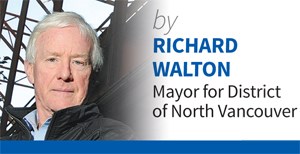There are very real concerns about the impact of rising housing costs in our community and across the Metro region.
Home ownership is now beyond the reach of many average families due to skyrocketing property prices and low vacancy rates. Here in the district our limited variety of housing types mean many folks are moving to other areas of our region and beyond in search of suitable and affordable housing.
If we don’t respond to this phenomenon we risk losing our young adults and families, some of whom are our critical community workers: teachers, nurses, firefighters, municipal workers, retailers and tradespeople who are the backbone of a healthy economy and community.
Issues around housing affordability aren’t new. I grew up in West Vancouver in the 1960s but couldn’t afford to live there as an adult, and neither could most of my friends. The difference is that, at that time, lower-cost options existed next door in neighbouring communities.
Many of us bought our first homes and started our families here in North Vancouver. We were fortunate to be able to set down roots in a place where we could continue the pattern of life we expected, closely located to our extended families.
The situation today is much different. Beyond staying at home with parents, there are today fewer economically feasible housing options for those who have more recently grown up here. Many young families are looking to Squamish or Maple Ridge and beyond, seeking affordability. As a result, we lose an important part of the fabric of our community and at the same time families are becoming more widely dispersed, which doesn’t bode well for the future health of our community, particularly as our baby boomer demographic ages and we need family support nearby.
Our Official Community Plan (OCP) directs the district to increase its housing options to meet the needs of residents of all ages and incomes. To help achieve that, we are developing a rental and affordable housing strategy.
Our objective is to create a district-specific approach that will guide the community, developers, council, and staff towards common goals in addressing our wide variety of housing needs. Work on this strategy began earlier this year, and this spring we reached out to the community for feedback through a district-wide telephone, in-person and online survey. The findings have helped us understand what kind of housing all of our residents say they need and measure the public’s awareness of issues related to affordability, allowing us to gather valuable input and ideas. That feedback, combined with input from non-profit housing agencies and development industry representatives, was used to inform our draft strategy.
The draft strategy outlines our high-level goals, which include expanding the diversity of our housing types, prioritizing the retention of affordable housing, enabling the replacement of existing rental housing where possible, minimizing impacts to existing tenants, increasing the supply of new rental and affordable housing, and partnering with other governments and agencies to deliver the affordable housing options our community needs. To learn more please visit dnv.org/housing.
The increasing cost of housing is an issue that stretches far beyond the borders of the district, as all of our neighbouring municipalities are struggling with the issue too, and just about every local government is working on finding solutions. And while we do want to deliver a customized strategy for our community, any action we take will reflect the learnings and best practices from around the region.
We live in a very desirable corner of the world and population growth is inevitable. I believe we should take a proactive approach rather than wish it away. Newcomers bring a fresh and vibrant energy to our community and help us see the future for what it can be, as opposed to simply a continuation of what is. Communities that plan well and actively manage growth can welcome newcomers and, at the same time, ensure those who have lived here for generations can continue to do so, affordably.



